Knights in the kitchen. Part of 1
As we know, knighthood as such did not appear in Europe immediately. It all started with the collapse of the Western Roman Empire in the 476 year, after which the era of the "dark ages" began, about which there is little information. However, it is known that the “military lords” of the barbarians who flooded Europe as a whole, quite favorably perceived by them the defeated Roman culture. Less than two centuries, as all the barbarians began to speak in spoiled Latin, from the pagans turned into Christians, in a word, they perceived a lot of ... enemy culture. This once again confirms that there is nothing enemy and nothing personal, but there is something that is profitable and not profitable. If faith helps keep people in check, sovereignty borrows it. The same can be said about the language and the kitchen. Beer, of course, is a good thing, but grape wine is tastier and drunker, and wheat bread is more delicious than millet and barley flatbreads. The Romans, by the way, were all the same. At first trousers - a marriage, were considered as clothes of barbarians. Special centurions walked around Rome and wrapped the Romans to the Romans - “have pants or not,” those who were in pants were severely punished for “barbarizing Roman culture”. Then ... then they were allowed to wear to the horsemen who fought in Britain, then to all the horsemen, then to all the legionaries, as a result even emperors put them on! It is clear that complex Roman dishes could not be claimed by the barbarian culture, but their memory still remained, as Roman Latin and the Christian religion remained. In addition, the Eastern Roman Empire continued to exist, where all the traditions and cuisine of the great Rome were preserved. That is, wild barbarians had before their eyes a specimen of culture, albeit inaccessible to their understanding, causing anger and envy, but subconsciously entrancingly enticing. So the basis for the development of a new society and new cultural traditions based on the synthesis of its own and the old Roman culture among the barbarians existed, and since it existed, then this synthesis was just a matter of time. By the way, Georgi Gulia wrote very well about how and how the Romans ate the empire epoch in his novel “Sulla”, which is worth reading just to describe the feasts of that time.
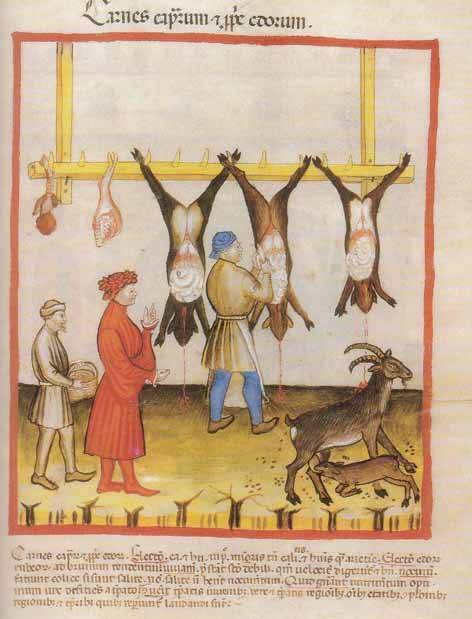
Medieval miniature from the manuscript "The Story of Health" with the image of the medieval carnage. Blood drains from carcasses of animals that have just been slaughtered. Next to the goat with a goat, waiting to be slaughtered, and their "nuts" - evidence of the hygiene of the place. Upper Italy near 1390 (Vienna National Library)
But the food of the Early Middle Ages was very scarce and consisted mainly of meat, fish and dairy products. The people of that time practically did not eat vegetables and fruits, except perhaps berries, mushrooms and nuts, although they did not disdain the fruits of wild apple trees. They preserved food for the future through smoking, drying and fermentation, and where there was plenty of salt, fish and meat were also salted. The basis of the food of the same Scandinavian Vikings was lamb, venison, bear meat, poultry, fish, and marine mollusks. Moreover, thanks to the Vikings, who instilled fear in Europe, its inhabitants learned such a berry as cranberries, which in the 10th - 12th centuries. got to them exclusively through them. Well, the Vikings themselves took it with them both as medicine and as a delicious dessert. Here is no scurvy and did not take them! Later, Russian merchants began importing cranberries into Europe, and they carried it both in the Baltic and around Scandinavia, and across the North Sea. So this product was very expensive and the poor can not afford. And the Vikings in the XII century. brought to England and Ireland ... rabbits, which by that time had already spread throughout Europe and were a tasty dish just for the poor! However, the rabbits ate well and know. When the locks of the feudal lords were built special rabbit ponds or pens. Moreover, their construction in France was regulated by a special royal ordinance, so that their sizes corresponded to the rank of the owner!

Humorous miniature "Rabbit Baker" from the manuscript "Hare Marginali", 1-th quarter of the XV century. (British Library, London)
It should be noted here that already in the Early Middle Ages, everything that was possible in Europe was ruled by the church. She forbade Christians to eat meat on Wednesdays, Fridays and Saturdays, all six weeks of Great Lent, and even during many other church holidays, which allowed them to save food in a significant way. An exception was made for children and patients who could be given strong meat broth. Chickens and other poultry meat was also not always considered! Well, of course, in the post you could eat fish. Therefore, large fish ponds were arranged at the monasteries - cages, so that fresh fish were always present on the table during monastic meals. It was the Swiss monks in the VIII. they came up with green cheese, and they called it “shabtsiger”, although the cheese itself was recorded only in the 1463 year. But we absolutely know for sure that in 774, Brie tasted the Brie cheese and came to him in complete delight: "I just tried one of the most exquisite dishes."
It was in the era of Charlemagne that cucumbers spread throughout Europe, while the Moors in the twelfth century. They brought cauliflower to Spain, from where it came to Italy a century later, and from there it began to spread throughout Europe.
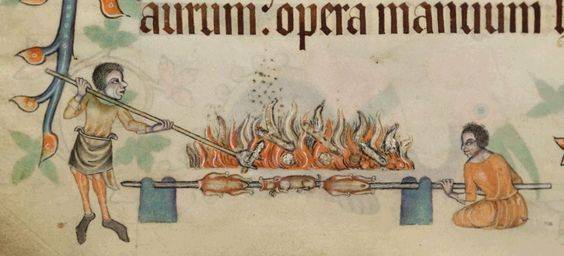
Miniature from the famous "Psalter Latrell." Cooking roast on a spit. OK. 1320-1340 Lincolnshire. (British Library, London)
Since the church and the monks in the Middle Ages were a universal role model, it is not surprising that the fish menu was very popular not only in monasteries, but also among laymen. Thus, the mention of carp is present in the orders to the governors (dyuki) of the provinces of the German minister Cassiodorus, who demanded that the table of the king of the Ostrogoths Theodoric (493 - 512) be regularly supplied fresh carp. And in France, carp began to breed with King Francis First (1494 - 1547).
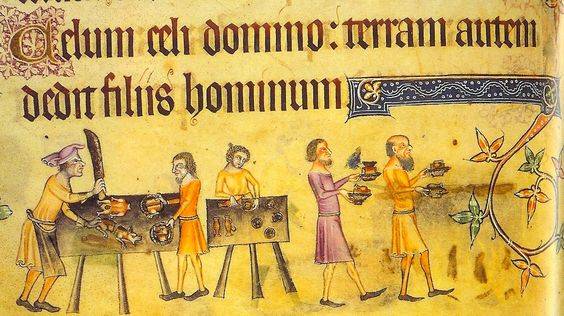
Another scene from Latrell's Psalter. Cooks prepare food in the kitchen, servants carry plates with food.
Accordingly, in England, all caught sturgeon belonged exclusively to the king. And the English king Edward the Second (born 1284, the king from 1307 to 1327 a year) loved sturgeon so much that he gave her the status of royal food, forbidden to be used by everyone else!
The continuation of the previous scene. Latrell feasts with the family, and servants serve food to the table.
Here we turn to our Russian medieval kitchen, because it was in it that the fish had a chance to play a very special role. The fact is that the Orthodox Church, like the Catholic Church, controlled practically all aspects of society’s life in Russia and indicated not only what and when to eat, but also what products and how to cook!
Milking sheep "Latrell Psalms".
In particular, before Peter the First, it was considered a sin ... to cut food before cooking. That is, it was possible to gut the same chicken, but after that it was necessary to cook it entirely, “as God gave it,” hence such dishes as “smoking in chains” (chicken cooked in broth filled with flour). Under Alexei Mikhailovich, a “sinful dish” appeared at the court, naturally borrowed from the “damned West” - “smoking separately under lemons,” that is, a chicken cut in half, laid out like a chakhokhbili, covered with lemon slices and baked in the oven. Well, just a very "sinful dish", because well, no products could be cut!

Medieval apiary. "Psalter Latrell."
Then the cabbage was not chopped, but with leaven, beet, turnip, turnip, either steamed or baked in pots, again, entirely. Well, mushrooms and cucumbers were also salted as they were by nature. That is why they baked pies in Russia with porridge, mushrooms (small, which were not needed to be cut!) And fish, which were baked in dough with ... scales, and ... bones, only gutted. It is clear that they baked not ruffs, but sturgeon and somatina (or somino, as they said in Russia), but the rule was one thing - not to cut food and food in dishes not to mix. Ivan the Terrible, for example, known for his piety, forbade, on pain of death, to fill sausages and also to "eat black grouse" (black grouses), who were worshiped in Russia along with rabbits and roosters unclean food. The “Krakow sausage” that we have today is the memory of those cruel times. It was only from Poland that the sausage came to us then, to make our own - it meant to immediately put our heads on the block.

The cat bit the mouse. Even then, many people understood that cats are extremely useful, as they exterminate mice, which destroy and spoil stocks of food raw materials. "Psalter Latrell."
Interestingly, with the same Alexei Mikhailovich salary archers issued ... meat of sheep. In the carcass per week foreman and half the carcass of the ordinary archer. So the whole carcass chopped ?! Obviously, this is what it means, so it was necessary to repent of it at confession ...
To be continued ...
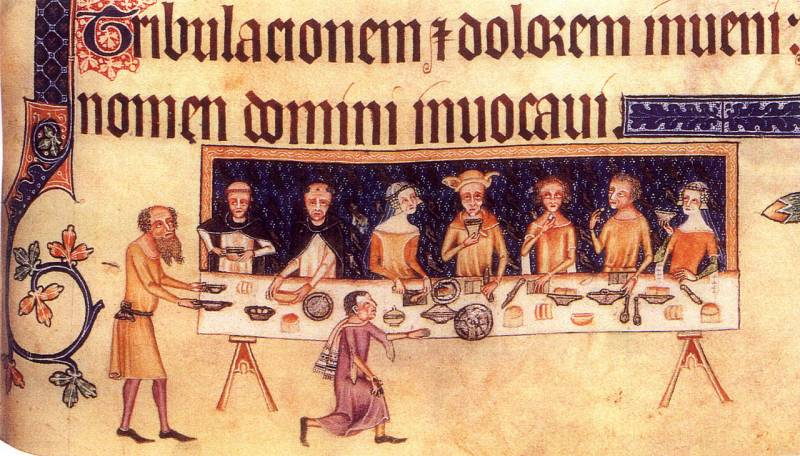
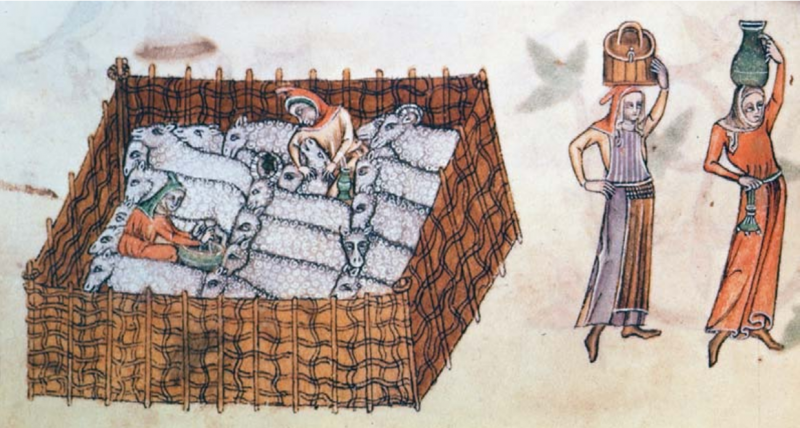
Information